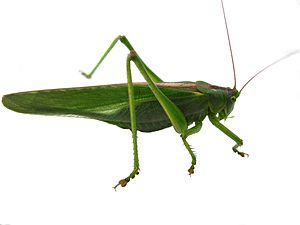Hayhorses
| Hayhorses | ||||||||||||
|---|---|---|---|---|---|---|---|---|---|---|---|---|

Green hay horse ( Tettigonia viridissima ), female |
||||||||||||
| Systematics | ||||||||||||
|
||||||||||||
| Scientific name | ||||||||||||
| Tettigonia | ||||||||||||
| Linnaeus , 1785 |
The hay horses ( Tettigonia ) represent a genus within the family of the whooper and the superfamily of the leaf locust .
features
All species from the genus of hay horses are quite large, massive grasshoppers, which are about 28 to 42 millimeters long. Most species are grass green, but some are also colored brown, which also serves as camouflage in the grass, including the wings, which represent leaves. The wings can be of different lengths, they can, for. B. as with the green hay horse protrude over the ovipositor and the animals are able to fly or, as with the twittering insect , only reach to the tip of the body and thus the animals can hardly fly. Wingless or extremely brachyptere species do not occur in the genus.
The males of Tettigonia can be distinguished from similar genera by the shape of the cerci, which are long and straight with a clear tooth in front of the middle or in the basal section. The ovipositor of the female is long and straight, it is at least two and a half times as long as the pronotum.
Occurrence
The hayhorses are spread over the entire Palearctic . They mostly inhabit grassy areas. Some species, such as the green hay horse , are quite undemanding and inhabit almost all landscapes.
Way of life
All types of hayhorses live mainly predatory on small insects. Plants are also seldom eaten, especially soft, herbaceous plants.
The loud singing of the males can be heard from noon until late into the night from July. The males are very territorial and drive males of the same species out of their territory. After mating, the female lays 200 to 600 eggs. The development can be six, but also seven stages. The adult animals can be seen from July.
Naming
The name Tettigonia Linnaeus, 1758 (a genus of locusts) is homonymous with Tettigonia Fabricius, 1775 (a genus of cicadas). The name for the genus of cicada is an invalid younger homonym, but is still widely used today.
species
European species
- Green hay horse ( Tettigonia viridissima ), Europe, North Africa, West and Central Asia, east to Tian Shan
- Chirping Shrimp ( Tettigonia cantans ), Europe, Siberia, east to Kazakhstan.
- Eastern hayhorse ( Tettigonia caudata ), Eastern Europe, West and Central Asia, east to Tian Shan
- Tettigonia hispanica , Spain (endemic to the mountains of central Spain)
- Tettigonia longispina , Sardinia
- Tettigonia silana , Italy
Non-European species
- Tettigonia acutipennis (Asia Minor)
- Tettigonia chinensis (South China)
- Tettigonia dolichoptera (Southeast Asia, Korea)
- Tettigonia ibuki (Japan)
- Tettigonia krugeri (Libya)
- Tettigonia longealata (Morocco)
- Tettigonia lozanoi (Algeria, Morocco)
- Tettigonia macrocephalus (Kyrgyzstan)
- Tettigonia macroxipha (Morocco)
- Tettigonia orientalis (Japan) (syn: Tettigonia yama )
- Tettigonia savignyi (Algeria, Egypt)
- Tettigonia tsushimensis (Japan)
- Tettigonia turcica (Asia Minor)
- Tettigonia ussuriana (Eastern Russia to Northern China, Korea)
- Tettigonia vaucheriana (Algeria, Morocco)
literature
- Heiko Bellman: The new cosmos insect guide. Kosmos Naturführer, Kosmos (Franckh-Kosmos), 2010, ISBN 978-3-440-11924-2
- M. Conception Pinedo (1985): Los Tettigoniidae de la Peninsula Iberica, Espana insular y norte de Africa. Eos 61: 241-263.
- S. Storoshenko (1994): Review of the Orthoptera of Eastern Palaearctica: Genus Tettigonia Linnaeus (Tettigoniidae, Tettigoniinae). Far Eastern Entomologist 3: pp. 1-20.